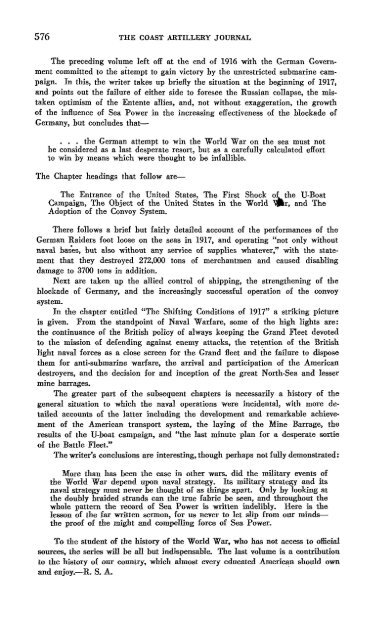COAST ARTILLERY, JOURNAL - Air Defense Artillery
COAST ARTILLERY, JOURNAL - Air Defense Artillery
COAST ARTILLERY, JOURNAL - Air Defense Artillery
Create successful ePaper yourself
Turn your PDF publications into a flip-book with our unique Google optimized e-Paper software.
576 THE <strong>COAST</strong> <strong>ARTILLERY</strong> <strong>JOURNAL</strong><br />
The preceding volume left off at the end of 1916 with the German Government<br />
committed to the attempt to gain victory by the unrestricted submarine campaign.<br />
In this, the writer takes up briefly the situation at the beginning of 1917,<br />
and points out the failure of either side to foresee the Russian collapse, the mistaken<br />
optimism of the Entente allies, and, not without exaggeration, the growth<br />
of the influence of Sea Power in the increasing effectiveness of the blockade of<br />
Germany, but concludes that-<br />
•.• the German attempt to win the World War on the sea must not<br />
be considered as a last desperate resort, but as a carefully calculated effort<br />
to win by means which were thought to be infallible.<br />
The Chapter headings that follow are-<br />
The Entrance of the United States, The First Shock ot the U-Boat<br />
Campaign, The Object of the United States in the World _r, and The<br />
Adoption of the Convoy System.<br />
There follows a brief but fairly detailed account of the performances of the<br />
German Raiders foot loose on the seas in 1917, and operating "not only without<br />
naval bases, but also without any service of supplies whatever," with the statement<br />
that they destroyed 272,000 tons of merchantmen and caused disabling<br />
damage to 3700 tons in addition.<br />
Next are taken up the allied control of shipping, the strengthening of the<br />
blockade of Germany, and the increasingly successful operation of the convoy<br />
system.<br />
In the chapter entitled "The Shifting Conditions of 1917" a striking picture<br />
is given. From the standpoint of Naval Warfare, some of the high lights are:<br />
the continuance of the British policy of always keeping the Grand Fleet devoted<br />
to the mission of defending against enemy attacks, the retention of the British<br />
light naval forces as a close screen for the Grand fleet and the failure to dispose<br />
them for anti-submarine warfare, the arrival and participation of the American<br />
destroyers, and the decision for and inception of the great North-Sea and lesser<br />
mine barrages.<br />
The greater part of the subsequent chapters is necessarily a history of the<br />
general situation to which the naval operations were incidental, with more detailed<br />
accounts of the latter including the development and remarkable achievement<br />
of the American transport system, the laying of the Mine Barrage, the<br />
results of the U-boat campaign, and "the last minute plan for a desperate sortie<br />
of the Battle Fleet."<br />
The writer's conclusions are interesting, though perhaps not fully demonstrated:<br />
More than has been the case in other wars. did the military events of<br />
the World War depend upon naval strategy. Its military strategy and its<br />
naval strategy must never be thought of as things apart. Only by looking at<br />
the doubly braided strands can the true fabric be seen, and throughout the<br />
whole pattern the record of Sea Power is written indelibly. Here is the<br />
lesson of the far written sermon, for us never to let slip from our mindsthe<br />
proof of the might and compelling force of Sea Power.<br />
To the student of the history of the World War, who has not access to official<br />
sources, the series will be all but indispensable. The last volume is a contribution<br />
to the history of our country, which almost every educated American should own<br />
and enjoy.-R. S. A.
















